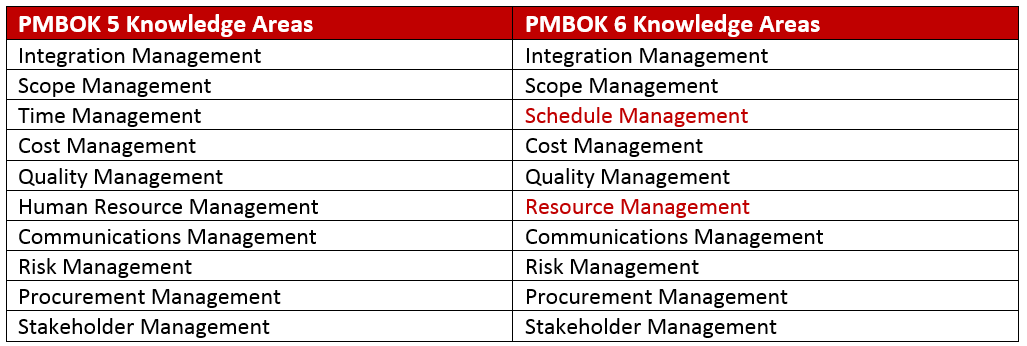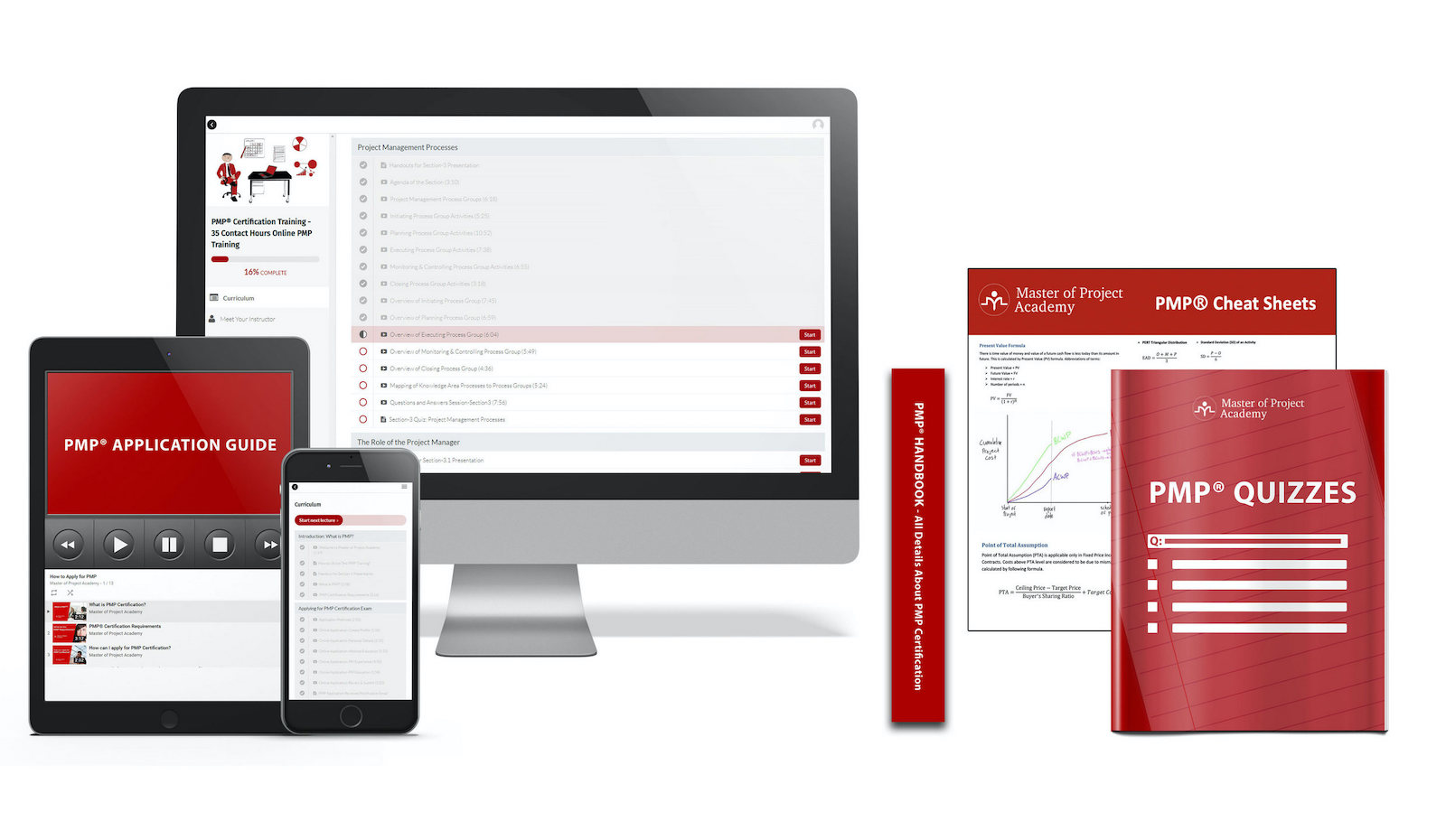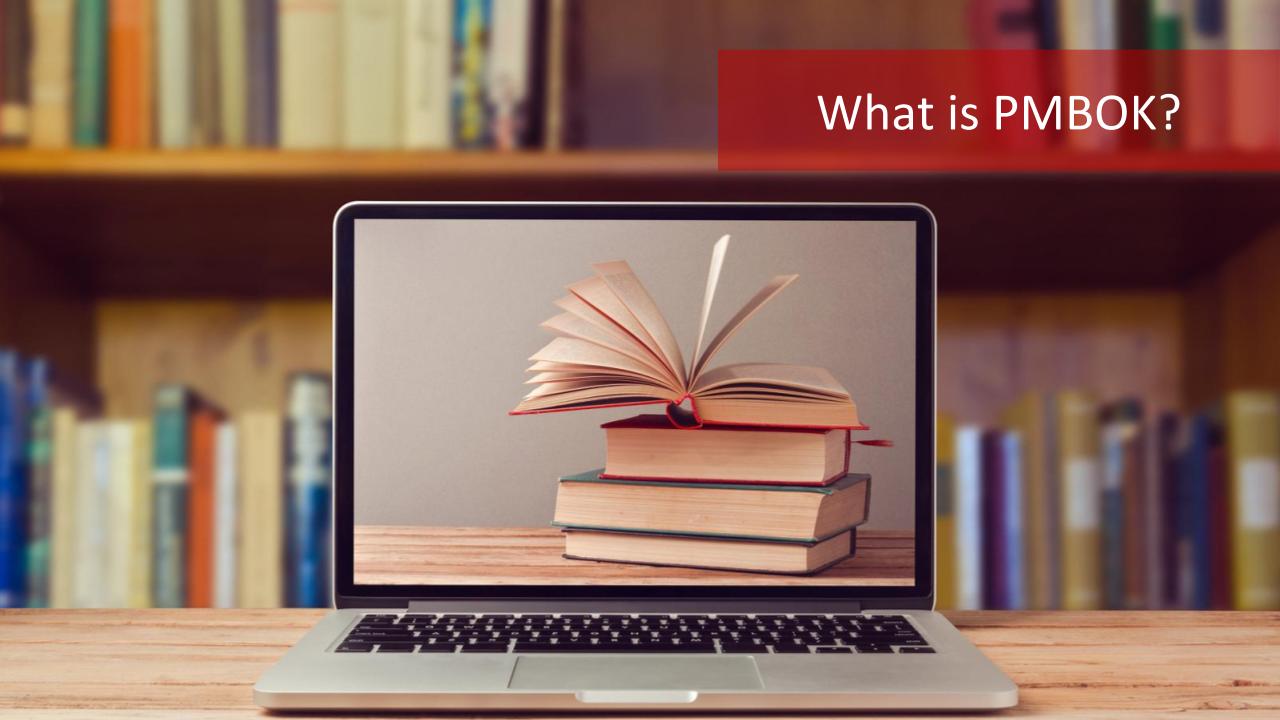Which is that one key resource that you can rely on for PMP certification? Definitely, PMBOK pdf is the most important resource for your PMP exam prep. If you are on the PMP project management professional journey, PMBOK PDF is a must-have. Why and what is there in PMBOK pdf? We are going to explore the PMBOK pdf in this article.
Attend our 100% Online & Self-Paced One-Hour Free PMP Training.
What is PMBOK pdf?
PMBOK pdf stands for Project Management Body of Knowledge which is produced by the world-renowned institute, Project Management Institute (PMI). PMBOK pdf contains the project management framework. It has been encapsulated with the combined knowledge of a huge number of practicing project management professionals who are members of PMI.
How is PMBOK available?
PMI institute is a globally present and recognized not-for-profit institute for project management. PMI advocates project management best practices and they offer various foundational and practice standards pertaining to project management. PMBOK pdf is the foundational Gold standard in project management.
Can I get PMBOK PDF as PMP Training Material?
This is actually one of the most frequently asked questions we receive from students. PMBOK PDF is the sole proprietary of PMI and no other organization can provide it as training material. However, during your PMP application, if you choose to be a PMI member as well, while the total cost for the PMP examination will not change, you will have access to the PMI library for one year, including PMBOK PDF. Therefore, we strongly recommend you apply for the option including the one-year PMI membership.
You can see further details in our PMP certification cost article.
How can I get a copy of the PMBOK pdf?
If you are a PMI member, you can get a personalized copy of the PMBOK pdf. You may log in to pmi.org and under mypmi, you can find the link to download the PMBOK pdf. While, if you are a non-member, you can purchase your copy of a paperback edition of PMBOK pdf from PMI. Again, if you are a member, you can buy the paperback edition at $49.50 and if you have not taken membership, you can get it at $65.50.
Check our “Should I use PMBOK® in my PMP® study?” video
Why be a PMI member and how?
Why are you interested in the PMBOK pdf? One, you want to go for PMP or CAPM certification, the other could be you are keen on understanding the best way of executing projects. Either way, if you take membership, you can get a discount for your PMP or CAPM certification exam too.
Even if you are only interested in gaining knowledge on project management, the membership gives you access to a host of resources on the PMI website ranging from whitepapers to webinars, guides, virtual events, etc.
You can log in to the PMI website and pay the membership fee of $139 to become a member.
PMBOK Pdf: What does it contain?
PMBOK is a guide to the project management body of knowledge. Did you know PMBOK pdf is updated periodically by the volunteer community comprising of project management professionals from the world over? This means you are getting access to world-class, global best practices.

Knowledge areas in PMBOK PDF
PMBOK pdf is organized as PMBOK knowledge areas with processes in each knowledge area. A knowledge area deals with a particular aspect of project management. There are ten knowledge areas in the PMBOK.
You have Integration, Scope, Time, Cost, Quality, Human Resources, Communications, Risk, Procurement, and Stakeholder knowledge areas. For example, Cost management covers the processes that are needed to define the way the cost management is to be done, estimating the various costs in a project, and creating a budget that needs to be controlled during project implementation.
Processes in PMBOK PDF
You cannot swallow the whole project management body of knowledge in one go. Therefore, PMBOK pdf is divided into knowledge areas to understand in depth a particular area such as cost or quality. You have in all 47 processes across the ten knowledge areas.
Watch Alan’s “New” PMP® Exam Journey Interview
Each process has certain inputs which are processed using various tools and techniques to get the desired outputs. There is interlinking between the processes of the knowledge area and also other knowledge areas as is seen in projects.
Introductory concepts in PMBOK PDF
PMBOK also discussed the basics of project management, the importance of organizational structures, and the five process groups. Initiating, Planning, Executing, Monitoring & Controlling, and Closing are the five process groups. The processes are spread across these five process groups and ten knowledge areas in PMBOK pdf.

PMBOK 6th Edition – Latest PMBOK PDF
PMBOK 6th Edition has been released in 2017 Q4 and the PMP exam changed for PMBOK 6th Ed after the 26th of March 2018. But what are the changes from the PMBOK 5th edition to PMBOK guide sixth edition?
PMBOK 6th edition Process Groups
There were 5 process groups in PMBOK 5: Initiating, Planning, Executing, Monitoring & Controlling, and Closing. These 5 process groups will remain the same in PMBOK 6th edition as well. There is essentially the same framework in PMBOK 6th edition too. A few additions in the number of processes and streamlining of processes to reflect current practices have been the focus of change to PMBOK 6th edition from the PMBOK 5th edition.
What is different in PMBOK 6?
In PMBOK 6th edition, the processes are organized around the process groups. Since processes are more relevant to the process group as compared to a knowledge area, PMBOK 6th edition has organized processes by process groups. As already mentioned, PMI listens to the practitioners and hence brought about this change in PMBOK 6th edition.
Change #1: Changes in total chapters in PMBOK 6th edition
We had a total of 13 chapters in the PMBOK 5th edition. Chapter 1-3 was to give you an overall picture of the project management framework and the role and skills of a project manager. It covered the concepts of the project, program, portfolio, and organizational structures in addition to the life cycle of a project.
PMBOK 6th edition consolidates these chapters. We have a new chapter on what a project manager is supposed to do. In addition to this, the skills and competencies you should possess as a Project manager are now aligned with the PMI Talent Triangle.
What is PMI Talent Triangle?
As a contemporary project manager, it is not enough if you have technical skills. The dynamically changing project environment and the evolving trends in the industry necessitate the project manager to have additional skills. What are the skills needed?

Strategic & Business Management
It is not enough to manage the triple constraints of a project. You need to understand the business alignment and fitment of the project. Therefore, you need strategic & business management skills. What does it involve?
With the changes in PMBOK 6th edition, you need to understand skills that help you analyze competition, and market, know the legal implications, business models, etc.
Leadership Skills
Though leadership skills were discussed in PMBOK 5, the PMBOK 6th edition gives a greater emphasis to these skills. Leadership skills include emotional intelligence, problem-solving, team building, and influencing which give you the needed competency to motivate your team.
Technical Skills
PMBOK 6th edition continues the need for skills with respect to the domain you are working in. In addition to this, you would need to know the performance management, earned value management, governance, life cycle management, etc. which were part of the earlier edition too.
Change #2: PMBOK 6th Edition Knowledge Areas:
There are 10 knowledge areas in PMBOK 5. These knowledge areas will still exist in PMBOK 6th edition but 2 of these knowledge areas will appear with new names as below in the table::

What changed in knowledge areas in PMBOK 6th edition?
As you have seen, the number did not change but the names of the two knowledge areas changed to better align with project needs. Now, every knowledge area in PMBOK 6th edition will have 4 additional sections. These are:
- Key concepts
- Tailoring considerations: Earlier edition had mentioned the need for tailoring but nothing specific was mentioned. PMBOK 6th edition has more detailed guidelines on these and an appendix was added that discusses the tailoring considerations. Using these tailoring guidelines, you know which processes to put more focus on that depends on the size of the project you are working on and of course the scope of work!
- What are the developments and New practices being used in project management are also discussed?
- Focus on Agile and adaptive methodology: keeping with the changing trend in various industries, PMBOK 6th edition has included what a project using agile or adaptive methodology may use
Why Name Change in PMBOK 6th Edition?

Human Resource Management
The human resource management knowledge area is renamed as Resource Management knowledge area. Definitely, this is a logical change that was needed, since many project managers have felt this need for a long time. Why only people when we need to also manage other materials, equipment, machines, etc.?
Because project management discipline does not cover human resources alone. It covers other types of resources as well. Physical resources (materials, equipment, licenses …etc) are also part of project management and their management is essential for success.
Often, equipment and tools are shared resources, and planning their availability and managing them is a critical aspect of successful project completion. Therefore, this Resource Management knowledge area now includes human resources and other resources too.
Time Management
The Time Management knowledge area is renamed as Schedule Management knowledge area to emphasize the importance of scheduling in project management. Moreover, this now supports the Practice Standard on this published by PMI – Practice Standard for Scheduling. Practice standards help you implement the concepts in the PMBOK. These practice standards detail how you can use the tools, techniques, and processes given in the foundation standards. PMBOK 6th edition is a foundation standard. Therefore, it makes sense to bring Time Management in line with the Practice Standard for scheduling.
Enroll in our FREE PMP Overview training to learn more about PMP Certification, and how to apply for PMP step-by-step.
What are the changes in the processes in PMBOK 6th Edition?

Change #3: Three New Processes in PMBOK 6th Edition:
Here is the tally of the processes: There will be three new processes in the PMBOK 6th edition.

Close procurement in the Procurement Knowledge area has been removed as a process and the content of this process clubbed with control procurement and close project. Close procurement was dealing with the closure of contracts of vendors which was generally not performed by project managers in most organizations. Hence, PMI implementing Kaizen and feedback into its processes has been modified to reflect reality.
Therefore the tally is PMBOK 5th edition 47 processes to which 3 added = 50 from which 1 removed, essentially becomes 50-1=49 in PMBOK 6th edition.
Manage Project Knowledge in PMBOK 6th edition:
This is the new process added to the Integration knowledge area under the execution process group and the total count in integration becomes 7. What is this process meant for in PMBOK 6th edition? Execution in Integration is where the deliverables are being created. This is where there is a need for decision-making. Hence, there is a need for processing data to information to knowledge & wisdom based on which the decisions will be made. Keeping with the current trends, knowledge is the power that will help project managers use the data crunching technologies and make informed decisions.
Implement Risk Response in PMBOK 6th Edition:
In risk management, earlier editions had planning risk response & control of risk (now monitor risk) while there was no explicit mention of implementation. Though the implementation was part of the execution process of integration, the need for explicit implementation was realized in the PMBOK 6th edition.
PMI survey also stated that many project failures are due to improper risk management. Hence, this implement risk response in execution is a needed addition to the risk management knowledge area.
Control Resources in PMBOK 6th edition
This is the new process which is for monitoring and controlling the different resources that are there in the project. This is aligned with the change in the knowledge area from Human Resources to a broader ‘Resource’ management. Hence, keeping track of the various resources and their utilization becomes imperative. Therefore, this control resources process has been added to the PMBOK 6th edition.
Change #4: Six Changes in Existing Processes in PMBOK 6th Edition:
There are slight changes in existing processes in PMBOK 6th Edition.
Estimate Activity Resources was belonging to the Planning Process Group and Time Management Knowledge Area. In PMBOK 6th edition, it is still belonging to the Planning Process Group but now it will be part of the Resource Management knowledge area.
6 processes are renamed in PMBOK 6 although the content of these processes remains the same. The table below shows the changes in process names from PMBOK 5 to PMBOK 6th edition.

The table shows the processes where there is either a name change or a new process added/moved.

Why have these been done? If you look at the changes that have been happening in the PMBOK over the years, one major reason is to bring uniformity while another is bridging the gaps that were there. These changes to the process names in PMBOK 6th edition reflect the reality in terms of what happens there.
Control to Monitor: While the project is executed, we observe (monitor) to understand what is happening and customize the strategy to meet changing needs. This is the realignment that has been done in communication, risk, and stakeholder knowledge areas for the processes in the monitor and controlling process group in PMBOK 6th edition.
Quality Management: While quality assurance is one way to manage quality during execution, there are also other aspects to be taken care of. This management of quality is what the name change reflects.
Stakeholder: During the project, it is essential to understand how to involve stakeholders, and their participation to ensure all the stakeholders are in consensus with the progress and results. Hence, the change to engagement in PMBOK 6th edition from management makes sense.
Comparison of processes by Knowledge Area in PMBOK 5th edition and PMBOK 6th edition:

Change #5: PMBOK 6th Edition Changes in Project Management Plan Components and Project Documents
- In PMBOK 5, project management plan components (procurement management plan, stakeholder management plan … etc.) were depicted as inputs/outputs to a process. In PMBOK 6th Edition, the project management plan itself will be depicted as input/output.
- Beneath the input/output table, a list of potential project management plan components is identified. However, the components of the project management plan will be input or updated depending on the needs of the project.
- Project documents are listed as an input and project document updates are listed as an output, as appropriate. Beneath the input/output table, there is a list of potential project documents that may be input or may be updated as an output. The needs of the project will determine the actual project documents that should be input or updated as an output.
Change #6: Agile in PMBOK 6th Edition
Again an addition to keep up with current practices is, adding more information on the iterative and adaptive methods. Therefore, this includes the agile methodology in PMBOK 6th edition. Many projects are embracing the agile methodology to deliver their projects. Hence, PMI has updated the PMBOK 6th edition with the relevant agile practices that are needed for each knowledge area. Moreover, an appendix containing practices used in an adaptive environment is a great change in PMBOK 6th edition.
Change #7: Other notable changes in PMBOK 6th Edition:
Escalate Response: During project execution, you may not be able to handle all the risks, and many need to be escalated to others to be addressed appropriately. You can do this in PMBOK 6th edition using ‘Escalate Response’
Scope: Though you may have seen the mention of the project scope as part of the total scope, PMBOK 6th edition emphasizes the importance of both product and project scope.
Many processes are renamed from control to monitor, bringing commonality in terms of tools and techniques used for each process are a few changes.
What changes can I expect in PMP Exam with PMBOK 6th edition?
Will there be a drastic change in the PMP exam when the PMBOK 6th edition comes? To answer this, we need to understand what impacts the PMP Exam:
PMP Exam will change in two instances:
- When PMBOK edition gets updated: As you have seen, there are quite a few changes in PMBOK 6th edition. The names of knowledge areas, processes, etc. have changed. A few new concepts were added. Therefore, the exam has to be aligned to the modified/updated content.
- Role Delineation Study: PMI advocates and practices continuous improvement. Therefore you see the PMBOK edition changing every few years, as it has now changed to PMBOK 6th edition.
- Exam Content Outline: The outline upon which the PMP Exam is based depends on the Role Delineation Study. The most recent study was conducted by PMI in 2015 and hence major changes in exam content may not be expected.
Therefore, exam terms may be realigned to reflect the PMBOK 6th edition changes.

Why do you need PMBOK PDF?
If you are a project manager and want to know how to plan and manage projects to ensure better success, you need to understand the framework of the PMBOK pdf. Moreover, you will also know the language of project management as spoken globally by project managers. You will be able to appreciate the importance of the various nuances that need to be addressed for better management of projects.
PMBOK pdf for PMP certification
Are you preparing for PMP or CAPM certification? Then you must read this! Have you completed your PMP exam requirements which also include 35 hours of PMP Training? Did you say yes? Then, your course may have already covered the concepts from the PMBOK pdf.
What is included in our 35 contact hours of self-paced PMP Training?
 Even if you have a PMP study guide given by your provider, understanding and internalizing the PMBOK concepts is the key to your becoming a PMP.
Even if you have a PMP study guide given by your provider, understanding and internalizing the PMBOK concepts is the key to your becoming a PMP.
Glossary in PMBOK
PMBOK has a glossary at the end which is a very useful resource for PMP certification. You can understand the various terms used by the global project management community by referring to this section. Moreover, some of the PMP Certification Exam questions are based on the definition of the key terms in PMBOK pdf. Even though you have a PMP Question Bank, going through the Glossary is a starting point. Also, it serves as a bite-sized knowledge or a PM nugget.
DFD in PMBOK
If you want to visually know how the outputs from one become an input to another process and the linkage between the different processes, go through the Data Flow Diagrams (DFD) in PMBOK.
Are you thinking that you can stop referring to the PMBOK pdf once you are certified? If yes, you are mistaken! You start referring to it more often during your project management. Moreover, an edition change happens because of some improvement. Therefore, it pays to keep yourself updated by going through the updated edition.
PMBOK PDFfor PMP Renewal:
You may attend an upgraded workshop on PMBOK’s new edition to know the changes and also get the needed Professional Development Units (PDU). As you are aware PMI stipulates that you need to earn 60 PDUs every three-year cycle to renew your PMP certification.
What Are the Benefits of PMBOK PDF?
Some of the benefits of PMBOK pdf are:
- Handy resource on project management
- Foundation for having the right knowledge to answer PMP and CAPM exam questions
- Helps you stay current on project management practices
Hence, PMBOK pdf is a bible that you need to have by your side as a project manager to ensure you keep yourself current.
Author Biography:

Sunanda Gundavajhala, B.Tech, M.B.A, PMP has over 25 years of project management. She is a consultant, trainer on project management for different sectors and is the recipient of “Recognition of Excellence” award from PMI, USA and Woman Volunteer award from Hyderabad, India Chapter of PMI. Sunanda has contributed to the “Practice Standard on Scheduling, PMI” while she has also worked as the Liaison Officer for PMIEF (Education Foundation) for the Hyderabad, India Chapter of PMI.



6 thoughts on “PMBOK PDF: How Can I Get PMBOK 6th Edition & All Content”
Comments are closed.